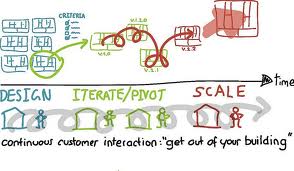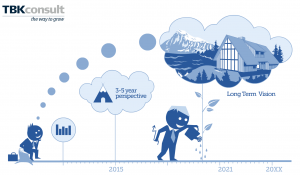From the Garage to the NYSE in 10 Years Flat – Starting a Software Company
Millions of new companies are started every year all over the globe. Most of these companies are local service providers trying to build a platform for feeding the owner and her family. None of these companies will make it to the New York Stock Exchange and they may live “happily ever after” nevertheless. By providing excellent services there is always room for new companies in any location. Hairdressers, restaurants, cafés, carpenters, lawyers, doctors, lawn movers, shops, brick layers, PR agencies, SPIN doctors, social media experts, coaches, etc.; they all fill a need that can feed a family well, and a vast majority have no other ambition than just that.
Software companies don’t have this option.
A software company must strive for a leading global market position. If they don’t they may not be able to feed their families for long. While local companies are typically labor intensive with value propositions linked to local delivery, software companies are typically IP intensive, somewhat capital intensive and [slider title=”much less dependent on local delivery.”] Some software requires a local delivery function for sales, implementation, customization, etc. [/slider]
Technology innovation happens in parallel all over the world. Rarely are ideas isolated to a few persons in a single location only. This holds true today more than ever. Irrespective of whether the technology is disruptive or sustaining, several people will be working independently of each other on maturing similar new technologies for the market. Technology almost always benefits from networking effects and technology vendors therefore always benefit from being [slider title=”first”] Being first to the mainstream market is NOT the same as being a “first mover”. Apple was not the first company to bring a tablet to the market, but they were the first to be able to take the mainstream market [/slider] to the mainstream market.
The recipe for rapid “Proof of Concept”

Over the last 10 years people such as Steve Blank, Eric Ries and Alexander Osterwalder have made substantial contributions to help technology start-ups reach Proof of Concept.
Thousands of “bright” ideas are conceived every day. The good ideas are those that get converted into products and services that customers pay money to acquire. I am sorry to say it, but there is no other definition of a good idea. Whether or not your idea requires a single, double or triple-sided business model, someone must find your offering so attractive that they will pay for it.
Over the last 15 years people such as Steve Blank, Eric Ries and Alexander Osterwalder have made substantial contributions to help technology start-ups reach Proof of Concept. Proof of Concept means that the start-up has found a business model that works. If you have an idea for a business and believe it could fly, purchase the books from Steve Blank, Eric Ries and Alexander Osterwalder (read them and use them). If applying the approaches suggested by these guys don’t bring you to Proof of Concept then your idea might be bright, but not the basis for a business. Try again with something different. Keep on trying until you get Proof of Concept.
Go for global!
The first thing I will add to the equation is “think global from the start.” Regardless of whether or not your business model is meant to be “no-touch-marketing-based” or “high-touch-sales-based”, no single market is big enough to make you the global leader. Even the US represents “only” 35,4% of the global market for technology. 64,6% of the global market is outside the US.
The second largest market, Germany (DACH), represents less than 8% of the global technology market leaving 92% outside Germany. See this series of articles on the consequences of a non-global mindset: Why are German software companies failing to get global market shares?
Tip: Irrespective of which business model you run, make English your first language.
Check what it takes to add more languages and adapt your software for local legal and market requirements. Prepare your software for this flexibility from the start and send me a “thank you” note the first time you get a call from a potential investor.
1,5 billion people are prepared to do business with you in English, 200 million in German and 5 million in Danish. If you start your business in a small country you may decide to skip your local language altogether and go directly for English. Under all circumstances make English your first language, and maybe your local language the second.
Choose your channel
My second recommendation is to choose your channel from the outset. Don’t make your channel to market an afterthought. I have been involved in a multitude of growth projects in the software industry. Some of them led to the IPO, some of them to acquisitions and some of them to oblivion. In the successful cases we had a crystal clear channel strategy from day one. It may not serve as scientific proof, but it is good enough for me. If you want to use a channel of third parties build that into your value proposition and your business model. Become black belts in recruiting and managing a partner based channel. If you are not prepared to do that, then forget the indirect channel and go direct. Oh, BTW – the choice may not be yours. Some value propositions are more appropriate for an indirect channel and vice versa.
The channel is an integral part of you business model. If you change the channel you have to redesign all the other business model elements as well.
Download my whitepaper on The Channel in a Business Model Context
Proof of Concept – and then what?
So you have proved that your business model works. Customers do spend money getting their hands on your products and services. How do you scale the business? More than 90% of all new technology businesses don’t make it to Proof of Concept. Of the remaining 10%, 90% never scale and eventually die also. Why is that so? Stay tuned for the next post in this series.
From the Garage to the NYSE in 10 Years Flat – Scaling a Software Company
Veeva: From the Garage to the NYSE in 6 Years Flat
Going Global on a Shoestring – The Dataco Case Story
Going Global on a Shoestring – The Successful Failure (Part 1)
Going Global on a Shoestring – The Successful Failure (Part 2)











